Eranda (Ricinus communis): Useful Parts, Qualities, Benefits & Uses
In the realm of natural remedies, Eranda, scientifically known as Ricinus communis, stands as an ancient yet timeless healer. With its origins deeply rooted in Ayurveda, it has been revered for centuries for its unparalleled medicinal properties. In this comprehensive guide, we delve into the multifaceted aspects of Eranda, exploring its essence, chemical composition, Ayurvedic qualities, and the myriad ways it influences our health and well-being.
What is Eranda?
Eranda, scientifically known as Ricinus communis, is a perennial flowering plant belonging to the Euphorbiaceae family. Commonly referred to as the castor oil plant, people cultivate it globally. It is renowned for its medicinal properties, especially in traditional medicine systems like Ayurveda. Its large palmate leaves and vibrant seeds are distinctive features. The plant’s seeds yield castor oil, valued for its therapeutic and industrial uses. It is often used as a natural laxative and is beneficial for various health issues. Its leaves, roots, and seeds are utilized in herbal formulations, showcasing its versatility. Eranda’s healing potential has made it a significant herb in natural medicine practices, addressing ailments and promoting overall well-being.
Vernacular Names of Eranda (Castor Plant)
-
English: Castor, Castor Bean, Castor Bean Plant, African Coffee Tree, Arandi, Bi Ma Zi, Bofareira
-
Hindi: Erand, Redi, Andi, Arand, Arend, Erend, Rendi, Erandah, Andih, Renda, Erandih
-
Bengali: Bherenda, Bhairenda, Rehri, Bhaerand, Bherenj
-
Telugu: Amudamu, Amadom, Amdi, Eranudapu, Erandama, Erandamu, Amudamuchettu
-
Tamil: Amanakku, Amanakkam, Kottai Muthu, Sittamunuk, Chittamant, Kattai Muthu
-
Marathi: Erandi, Yarandicha, Erandah, Rendi
-
Malayalam: Avanakku, Chittamanakku
-
Gujarati: Diveligo, Diveli Erandi, Erandah, Divelo, Erandioh, Erandoh, Rendi
-
Kannada: Haralu, Harlu, Manda, Oudla
-
Farsi (Persian): Bed Anjeer, Ved Anjir
-
Arabic: Khirva, Khriva, Khriba
-
Punjabi: Aneru, Arand, Arind
-
Assamese: Eri
-
Rajasthani: Edia, Arend
-
Kumaoni: Ind, Rendi
-
Lepcha: Rak-lop
-
Nepali: Areta, Alha, Orer
-
Oriya (Odia): Gab
-
Sindhi: Ayrun-kukri, Heran
-
Burmese: Kyeksu, Kesu
-
Chinese: Pee-ma
-
Egyptian: Kiki
-
Sinhalese: Endaru
-
Sumatran: Farak
-
Bombay (Mumbai region): Erendi, Gab
-
Santal: Eradom
Sanskrit Synonyms of Eranda (Castor Plant)
-
Eranda –
Derived from “Erayathi Vayu Iti Eranda”, meaning “the one that drives away or balances Vata Dosha”. It helps relieve stiffness and promotes movement. -
Gandharva Hasta –
“The hand of Gandharva (celestial being)”. The leaf resembles the hand of a mystical creature called Gandharva. -
Yaksha Hasta –
“Hand of Yaksha (nature spirit)”. Again, refers to the shape of the leaf that resembles a hand. -
Panchangula –
From “Pancha Puthrathvath Panchangula”, meaning “resembling a palm with five fingers”. -
Deergha Danda –
“Long stalk”, referring to the long petiole (leaf stalk) of the plant. -
Vardhamana –
“The one that grows quickly” or “ever-increasing”. -
Vyaghrapuccha –
From “Vyaghrasya Puccha Eva Pushpa Guccha Asya”, meaning “its flower cluster resembles the tail of a tiger”. -
Rubu / Rubaka / Urubaka –
These names indicate “the one that removes or balances aggravated Vata (air element)”. -
Vyadambaka / Vyadambara –
Refers to a plant that acts as a purgative, helping in cleansing the bowels (mala shodhaka). -
Hastikarni –
“Elephant-eared”, referring to the large size of the leaves. -
Chitraka –
From “Chithrayathi Ashrayam Karothi Vayu Adhi Roga Nivaranena”, meaning “the one that alleviates Vata-related diseases”. -
Uttanapatraka / Uttana Patraka –
“The one with erect leaves and petioles”. -
Aamanda / Amanda –
“Beautiful or attractive plant”. -
Chithra Bija –
From “Chithrani Chithrithani Bijani Asya”, meaning “the seeds are colorful and have varied designs”. -
Vathari –
From “Vathasya Ari:Shathru: nashako va ethi”, meaning “enemy of Vata, i.e., the one that destroys or alleviates Vata-related disorders”. -
Chanchu –
Refers to the beak-like projection of female flowers.
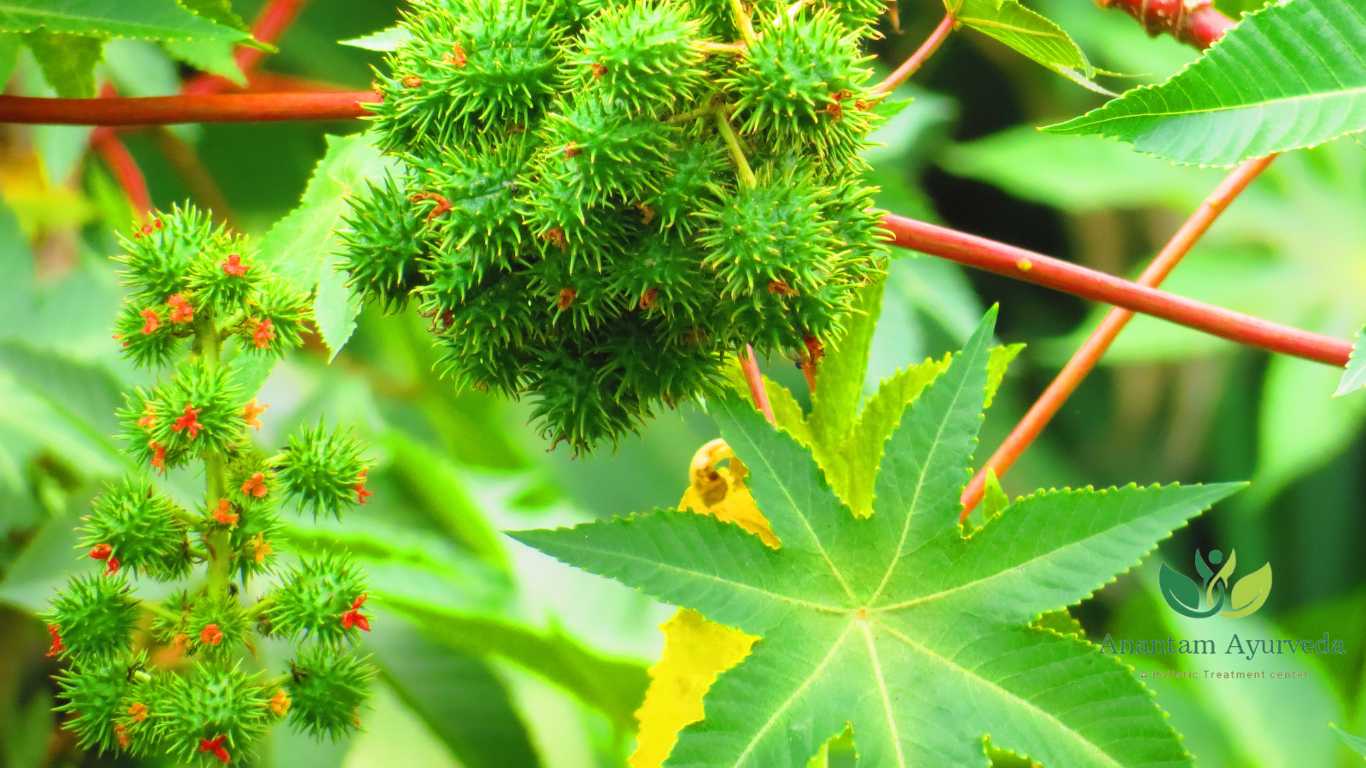
Botanical Taxonomy
-
Kingdom: Plantae
-
Subkingdom: Phanerogamae (Seed-producing plants)
-
Division: Angiospermae (Flowering plants)
-
Class: Dicotyledonae (Plants with two seed leaves)
-
Subclass: Archichlamydeae (Primitive flowering plants with free petals)
-
Family: Euphorbiaceae (Spurge family)
-
Genus: Ricinus
-
Species: Ricinus communis
Varieties of Eranda
According to various classical Ayurvedic texts, two main varieties of Eranda are mentioned:
-
Shveta Eranda – The White variety
-
Rakta Eranda – The Red variety
These varieties are described in the following Ayurvedic texts:
-
Dhanvantari Nighantu
-
Sodhala Nighantu
-
Kaiyadeva Nighantu
-
Bhava Prakasha Nighantu
-
Raja Nighantu
In addition, Raja Narahari described another variety: 3. Sthula Eranda – The Thick or Stout variety
Note: Both the Red and White varieties are botanically identified as Ricinus communis.
Classical Categorization of Eranda
Eranda is mentioned across major Ayurvedic treatises like Charaka Samhita, Sushruta Samhita, and Ashtanga Hridaya (Vagbhata), with diverse therapeutic uses.
Charaka Samhita:
-
Bhedaniya – Group of herbs that induce purgation (mild laxative effect)
-
Angamarda Prashamana – Herbs that relieve body aches and pains
-
Svedopaga – Useful in sudation therapy (sweating treatments)
Sushruta Samhita:
-
Included in the group Vidarigandhadi
-
Adhobhagahara – Herbs that promote Virechana (elimination of toxins through the rectal route)
-
Vata Samshamana – Effective in pacifying aggravated Vata dosha
Ashtanga Hridaya (Vagbhata):
-
Also included in the Vidarigandhadi group
The Chemical Composition of Eranda
The castor plant (Ricinus communis) contains a powerful combination of medicinal compounds, making it a key ingredient in both traditional and modern herbal medicine. These compounds exist in various parts of the plant, including its seeds, leaves, seed coat, and oil. The plant is best known for its purgative, anti-inflammatory, and antioxidant properties.
Key Compounds in Castor Seeds and Leaves
Castor seeds and leaves produce Ricinine, a naturally occurring toxic alkaloid, and
1-methyl-3-cyano-4-methoxy-2-pyridone, a pyridone derivative. These compounds contribute to the plant’s biological activity.
Bioactive Compounds in the Castor Seed Coat
The seed coat of Ricinus communis contains:
-
Lupeol – A potent anti-inflammatory and anticancer agent
-
Lipids – Provide energy and support various metabolic processes
-
Phosphatides (Phospholipids) – Play a vital role in cell membrane structure and function
Chemical Constituents in Castor Seed Oil
Castor oil is the most valued extract from the plant due to its rich chemical composition. It contains:
-
Ricinoleic acid – The main active compound responsible for castor oil’s strong laxative (purgative) effect
-
Arachidic acid – A long-chain saturated fatty acid
-
Palmitic acid – Common in many plants, offers moisturizing benefits
-
Stearic acid – Helps cleanse and soften the skin
-
Hydroxy stearic acid – Supports skin hydration
-
Oleic acid – Offers anti-inflammatory and healing properties
-
Chlorogenic acid – A powerful antioxidant
-
Hexadecanoic acid – Another name for palmitic acid, supports emollient action
-
Hydrocyanic acid – Present in trace amounts; toxic in high doses
-
Uric acid – Found in trace levels
-
Squalene – A natural antioxidant that supports skin health
-
Tocopherols (Vitamin E) – Powerful antioxidants that protect cells from damage
Additional Active Ingredients
Besides the major fatty acids, castor oil also contains:
-
Fixed oils – Useful in medicine and cosmetics
-
Ricin (resin) – A highly toxic protein with strong purgative effects
-
Glyseroids – Fat-based compounds that contribute to oil’s texture and absorption
Medicinal Properties and Uses of Ricinus communis (Castor Plant)
The castor plant (Ricinus communis) holds a prominent place in traditional Ayurvedic medicine due to its potent purgative, anti-inflammatory, and vata-kapha balancing effects. Various parts of the plant—root, leaves, seeds, and oil—offer significant therapeutic benefits.
Ayurvedic Properties of Castor (Eranda)
-
Taste (Rasa):
-
Madhura (Sweet)
-
Katu (Pungent)
-
Kashaya (Astringent)
-
-
Qualities (Guna):
-
Snigdha – Oily, unctuous
-
Teekshna – Sharp, penetrating
-
Sookshma – Minute, capable of entering subtle body channels
-
-
Post-digestive Effect (Vipaka):
-
Madhura – Sweet after digestion
-
-
Potency (Veerya):
-
Ushna – Hot in nature
-
-
Effect on Tridosha:
-
Balances Vata and Kapha Doshas
-
Utility of Castor in India
India utilizes nearly 95% of castor seed production for oil extraction, while the remaining 5% is reserved for seed propagation. Castor oil remains a staple in traditional remedies, cosmetic formulations, and industrial applications.
Types of Castor Plant
Based on Color:
-
Red Variety (Rakta Eranda)
-
White Variety (Shveta Eranda)
Based on Growth Cycle:
-
Annual Variety
-
Perennial Variety
Sanskrit Insight
In Ayurveda, Eranda is praised for its ability to relieve Vata disorders, muscle stiffness, and digestive issues. It also acts as a mild purgative, helps in detoxification, and supports the nervous system.
Castor Plant – Therapeutic Uses
-
Purgative – Helps cleanse the bowel
-
Anti-inflammatory – Reduces swelling and joint pain
-
Analgesic – Relieves muscle aches
-
Carminative – Eases bloating and abdominal gas
-
Lactation aid – Increases breast milk (in small, appropriate doses)
-
Skin healing – Promotes wound healing and moisturizes dry skin
Parts Used & Dosage
| Part Used | Form | Dosage |
|---|---|---|
| Root | Powder | 3–5 grams |
| Root | Decoction | 50–100 ml |
| Seeds | Crushed | 1–5 grams |
| Castor Oil | Liquid | 5–10 ml |
⚠️ Fatal Dose: 5–10 crushed seeds
⚠️ Fatal Period: 2 to several days (due to toxicity of ricin)
Morphological Features of Ricinus communis
-
Stem: Erect, herbaceous above, woody below
-
Leaves: Alternate, broad, palmately lobed, gland-dotted; green or reddish, with long petioles and reticulate venation
-
Inflorescence: Terminal
-
Flowers: Monoecious (both male and female flowers on the same plant)
-
Fruit: Globose, three-seeded capsule, covered in soft or hard prickles; explodes when mature (explosively dehiscent)
-
Seeds: Carunculate, with oily endosperm
Geographical Distribution of Ricinus communis (Castor Plant)
The castor plant (Ricinus communis) grows abundantly in tropical and subtropical regions across the world. While many believe it to be native to tropical Africa, it also grows indigenously in parts of the southeastern Mediterranean Basin, Eastern Africa, and India.
In India, castor thrives widely across the country, especially in the hotter and drier regions. Farmers commonly cultivate it in gardens, agricultural fields, and it often grows wild in wastelands and uncultivated areas.
Thanks to its adaptability, Ricinus communis flourishes in various soil types and climatic conditions, making it a versatile crop with both medicinal and industrial value.

Castor Root (Eranda Mool) Benefits
| Ayurvedic Action | Health Benefit / Condition Treated |
|---|---|
| Udavartahara | Relieves bloating and abdominal gas |
| Pleehaghna | Treats spleen disorders and splenomegaly |
| Gulmahara | Useful in abdominal tumors |
| Bastishoolahara | Eases bladder pain |
| Antravruddhinut | Supports hernia management |
| Shonita Vikara | Balances blood-related disorders |
| Shoshahara | Reduces emaciation and dehydration |
| Shoolaghna | Relieves abdominal colic pain |
| Margashodhana | Cleanses the gut |
| Shwasahara | Helps with asthma and respiratory issues |
| Kasahara | Alleviates cough and cold |
| Anahahara | Treats abdominal fullness and gas |
| Kati Basti Rujahara | Soothes lower back and bladder pain |
| Shiroruji | Relieves headaches |
| Mehahara | Manages urinary tract disorders and diabetes |
| Amavatahara | Effective in treating rheumatoid arthritis |
| Shothahara | Reduces inflammation and swelling |
Castor Root Bark (Eranda Mool Tvak) Benefits
| Property | Uses |
|---|---|
| Emetic & Purgative | Clears digestive tract |
| Analgesic | Treats lumbago and arthritis |
| Skin Tonic | Useful in skin diseases and leprosy |
| Respiratory Aid | Used for dyspnea and bronchitis |
| Digestive Support | Aids in flatulence, piles, dyspepsia, and calculus |
| Nervous System | Treats mental disorders, headache, and painful urination |
| Diuretic | Treats urinary tract issues, hydrocele |
| Antipyretic | Useful in fever and inflammatory conditions |
Castor Flower Benefits
| Property | Uses |
|---|---|
| Vata-balancing | Helps regulate Vata Dosha |
| Glandular Aid | Useful in glandular tumors |
| Urodynia Relief | Treats painful urination |
| Caution | May worsen bleeding disorders |
Castor Fruit (Eranda Phala) Benefits
| Ayurvedic Property | Health Benefit / Usage |
|---|---|
| Svaadu (Sweet) | Mildly nourishing |
| Sakshara (Alkaline) | Strong in nature |
| Laghu (Light) | Easy to digest |
| Ushna (Hot) | Enhances digestive fire |
| Bhedi (Purgative) | Relieves constipation, clears bowel |
| Vatajit | Balances Vata Dosha |
| Treats | Liver/spleen disorders, ascites, abdominal tumors, piles |
| Improves Digestion | Acts as a Deepana |
| Seed Notes | Seeds without hull: Used in birth control, leprosy, syphilis |
| Toxicity | Seed hull is poisonous and not used internally |
Castor Leaf Benefits
| Ayurvedic Action | Health Benefit / Use |
|---|---|
| Vataghna | Balances Vata Dosha |
| Kaphahara | Reduces Kapha Dosha |
| Krimihara | Antimicrobial; treats worm infestations |
| Mutradoshahara | Treats urinary infections |
| Pitta Prakopi | Increases Pitta (use with caution in Pitta individuals) |
| Gulmahara | Treats abdominal tumors |
| Bastishoolahara | Relieves bladder pain |
| Vruddhi | Useful in hernia |
| Mutrakrichrahara | Acts as diuretic, relieves urinary retention |
| Snakebite Remedy | Detoxifies remnant poison after snakebite |
| External Use | Treats boils, sores, arthritis pain, burns |
| Additional Uses | Used in night blindness, rheumatoid arthritis, arthralgia |
Castor Seed & Oil Benefits
| Component | Property / Action | Usage |
|---|---|---|
| Castor Seeds | Acrid, digestive, aphrodisiac, thermogenic | Treats dyspepsia, liver conditions |
| Castor Oil | Slightly bitter, antipyretic, viscous, thermogenic | Used for fever, inflammation, skin issues |
| White Variety | Preferred in fever treatment | Internal and external use |
| Red Variety | Used for swelling, mental disorders, pallor | Often used externally |
| Toxic Note | Hull is poisonous, seeds should be used only with expert guidance | Internal use under medical supervision only |
External Applications
| Application | Method |
|---|---|
| Arthritis, Sciatica, Pain | Heat castor leaf in sesame oil, apply to joints or painful area |
| Migraine, Back Pain, Skin Disorders | Apply warm paste of castor root + oil to affected area |
| Mastitis, Boils, Inflammation | Use leaf or root poultice externally |
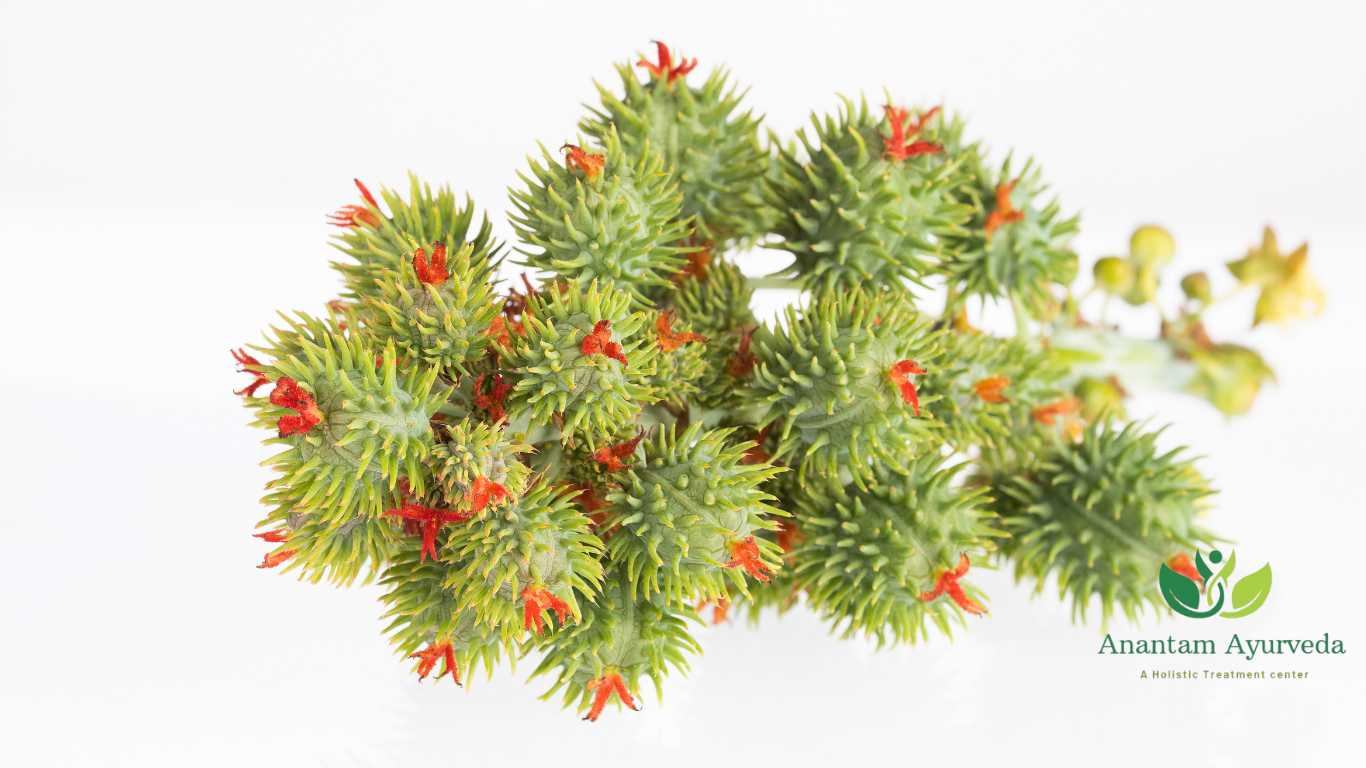
Home Remedies Using Eranda
| Condition | Remedy | How to Use | Effect / Benefit |
|---|---|---|---|
| Jaundice | Tender Castor Leaf Paste | Collect coppery-red tender castor leaves, make a fine paste, and take early morning on empty stomach | Reduces bile and helps in managing jaundice |
| Swelling (muscular) | Mature Castor Leaf Paste with Salt | Make paste of mature leaves, mix with salt, warm slightly, and apply over swollen area | Reduces muscular swelling and relieves pain |
| Backache, Sciatica, Constipation | Castor Root Decoction / Medicated Milk | Boil 20–25g of dried root to make decoction; take 40ml twice daily or prepare as medicated milk | Relieves back pain, sciatica, and constipation |
| Gouty Arthritis | Sesame Oil Smeared Castor Leaf Application | Smear sesame oil over castor leaf, warm slightly, and apply to gout-affected joints daily for a week | Reduces joint pain and swelling in gout |
| Worm Infestation | Palasha (Butea monosperma) Seed Powder + Castor Oil | Take 1–2 pinches of Palasha seed powder with castor oil on empty stomach | Expels pinworms effectively in 3–4 days |
Toxicity, Poisonous Action & Detoxification of Castor Plant (Ricinus communis)
Although Ricinus communis is widely used for its medicinal benefits, certain parts of the plant—especially the seeds—contain highly toxic compounds such as ricin, making proper usage and detoxification essential.
Toxic Substances in Castor Plant
| Part | Toxic Component | Toxicity Level |
|---|---|---|
| Seeds | Ricin (a toxic albumin protein) | 2.8–3.0% in whole seeds, 10% in seed flour |
| Root Bark | Strong purgative (externally used) | Can be harmful if misused internally |
Castor oil is mildly laxative and generally safe in small, therapeutic doses. However, raw seeds are highly poisonous, especially when consumed in large quantities.
Symptoms of Ricin Poisoning
Symptoms may take several hours to appear. They depend on the route of exposure (oral, inhalation, injection).
| System Affected | Toxic Effects |
|---|---|
| Gastrointestinal | Vomiting, abdominal colic, hemorrhagic gastroenteritis |
| Nervous System | Stupor, convulsions |
| Circulatory System | Edema, circulatory collapse |
| Eyes | Inflammation (in case of exposure/contact) |
⚠️ Note: Ingesting just 5–10 castor seeds may prove fatal in adults. Children and animals are even more vulnerable.
Treatment for Ricin Poisoning
If ricin poisoning is suspected, seek emergency medical care immediately.
| Step | Treatment Action |
|---|---|
| Gastric Lavage | Washes out stomach contents if poisoning is recent |
| Saline Cathartics | Promote rapid bowel elimination |
| Fluid and Electrolyte Management | Maintains hydration and organ function |
| Symptomatic Measures | Addresses vomiting, pain, shock, and other acute symptoms |
Detoxification (Shodhana) of Castor Seeds – Eranda Shodhana
To safely use castor seeds for internal purposes, Ayurveda recommends Shodhana (purification):
| Step | Method |
|---|---|
| Fomentation in Coconut Water | Soak castor seeds in coconut water for 3 hours |
| Washing | Rinse thoroughly with clean water |
| Drying | Dry the seeds under direct sunlight |
This traditional purification reduces toxicity and enhances the medicinal value of the seeds.
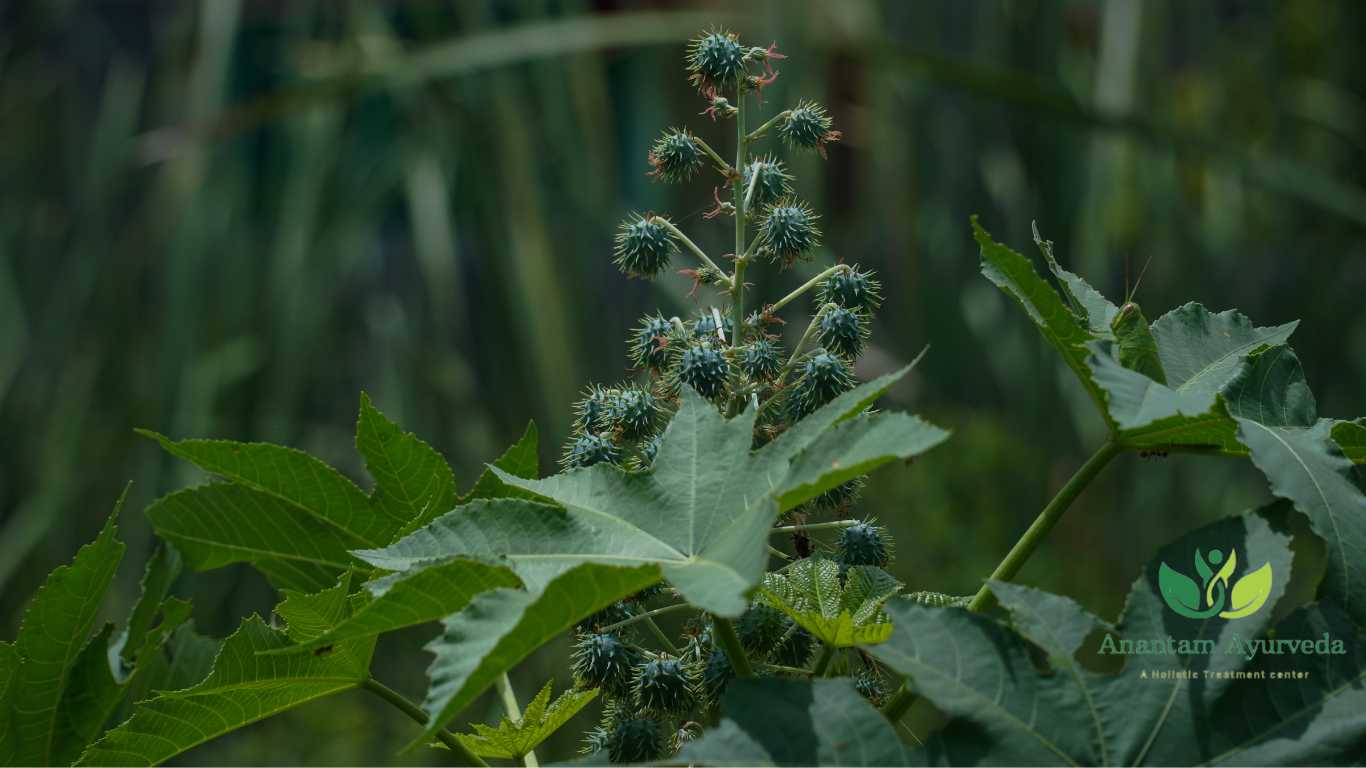
Research and Studies on Eranda (Ricinus communis)
Explore how modern science backs the traditional Ayurvedic uses of Eranda (Castor plant) with proven pharmacological and therapeutic properties.
Phytochemical Composition
-
Wild vs. Cultivated Varieties (2013): A study compared the phytochemical profiles of wild and cultivated varieties of Ricinus communis. Both were found to contain active compounds such as flavonoids, tannins, and alkaloids, contributing to their traditional medicinal uses.
Pharmacological Activities
-
Anti-inflammatory and Analgesic Effects (2016): Extracts from the leaves and roots showed significant anti-inflammatory and pain-relieving effects, supporting their use in treating rheumatism, back pain, and arthritis.
-
Wound Healing (2018): Presence of flavonoids and tannins in castor oil was linked to strong antioxidant and antimicrobial actions, which help accelerate wound healing.
-
Antidiabetic Potential (2008): A 50% ethanolic extract of Ricinus communis roots demonstrated hypoglycemic effects in diabetic animal models, suggesting potential in managing blood sugar levels.
Toxicity and Safety Assessments
-
Ricin Toxicity (2021): Ricin, a potent toxin found in castor seeds, can be lethal even in small doses. Toxic symptoms may include vomiting, abdominal pain, hemorrhagic gastroenteritis, stupor, convulsions, and circulatory collapse.
-
Detoxification Processes (2024): Traditional Ayurvedic detoxification techniques, such as Shodhana (purification), were shown to significantly reduce plant toxicity, enhancing safety for therapeutic use.
Ayurvedic Significance
-
Balancing Doshas (2020): Ayurvedic researchers emphasized that Eranda effectively balances Vata Dosha. The plant relieves conditions like rheumatoid arthritis, constipation, neurological pain, sciatica and paralysis, supporting its extensive use in Ayurvedic therapy.
Recent Research Highlights
-
Toxicological Assessments (2010): Root extracts of Ricinus communis were found safe up to certain dosages in experimental animals, showing no toxic symptoms or mortality.
-
Pharmacological Reviews (2023): Recent reviews summarized the plant’s extensive pharmacological profile, including potential anticancer, antimicrobial, anti-inflammatory, and hepatoprotective activities.
Key Takeaways
-
Modern research strongly supports the traditional Ayurvedic use of Eranda.
-
Scientific studies confirm its therapeutic, purgative, anti-inflammatory, and detoxifying effects.
-
When properly purified, Eranda offers safe and effective natural treatment options for various health conditions.
Health Benefits of Eranda (Ricinus Communis)
Eranda, scientifically known as Ricinus communis, boasts a plethora of health benefits rooted in its rich medicinal properties.
- Digestive Health: It acts as a natural laxative, promoting regular bowel movements and relieving constipation. Its gentle yet effective action on the digestive system helps in detoxification and encourages a healthy gut.
- Pain Relief: Eranda’s anti-inflammatory properties make it invaluable for managing pain, especially joint pain and muscle soreness. Applying Eranda oil topically on affected areas can significantly reduce discomfort and improve mobility.
- Skin Care: Eranda oil nourishes the skin deeply. Its moisturizing qualities hydrate the skin, making it supple and radiant. Additionally, it can help alleviate various skin conditions, providing relief from dryness, itching, and redness.
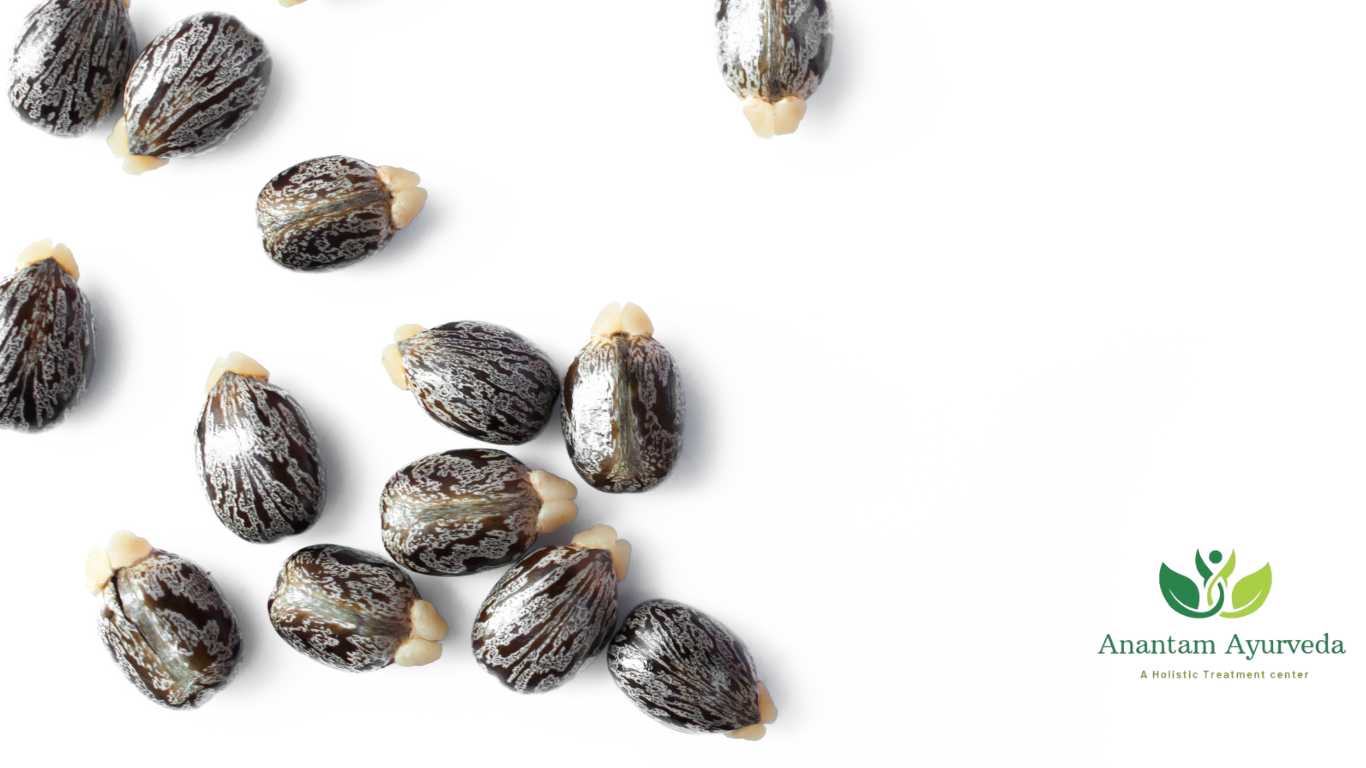
- Immune Boost: It contains compounds that enhance the immune system, making the body more resilient against infections. Regular consumption of Eranda-based formulations strengthens the body’s natural defense mechanisms.
- Hair Health: When applied to the scalp, Eranda oil promotes hair growth and prevents hair loss. It nourishes the hair follicles, making hair stronger and healthier.
- Anti-Inflammatory: It possesses potent anti-inflammatory properties, making it beneficial for conditions like arthritis and gout. It reduces inflammation, easing pain and improving joint function.
- Detoxification: It aids in detoxifying the body by promoting the elimination of waste and toxins. This cleansing action supports overall health and vitality.
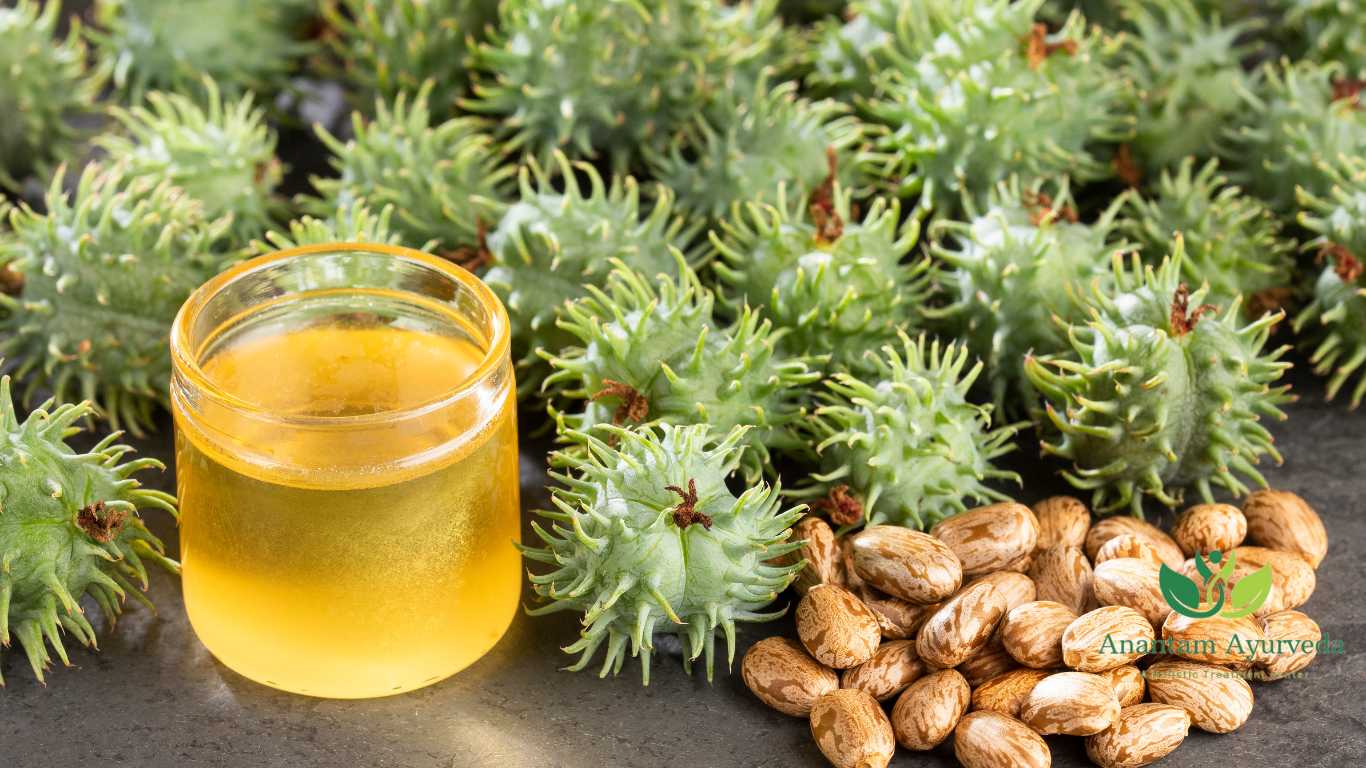
How to Use Eranda (Ricinus Communis)
In Ayurveda, Eranda (Ricinus communis) is a versatile herb with various applications. Here are the traditional Ayurvedic methods of using it:
1. Eranda Oil:
The most common form of Eranda used in Ayurveda is its oil. This oil is extracted from the seeds and is highly prized for its medicinal properties.
-
- Oral Consumption: Take a small quantity of Eranda oil (usually a teaspoon) mixed with warm water or milk. This is beneficial for digestive issues and as a mild laxative.
- External Application: Apply Eranda oil externally on joints and muscles. Gently massage the affected areas to alleviate pain and inflammation. It is especially useful in conditions like arthritis and muscle soreness.
- Hair and Scalp Treatment: Massage Eranda oil into the scalp to promote hair growth and improve hair texture. Leave it on for some time before washing it off with a mild herbal shampoo.
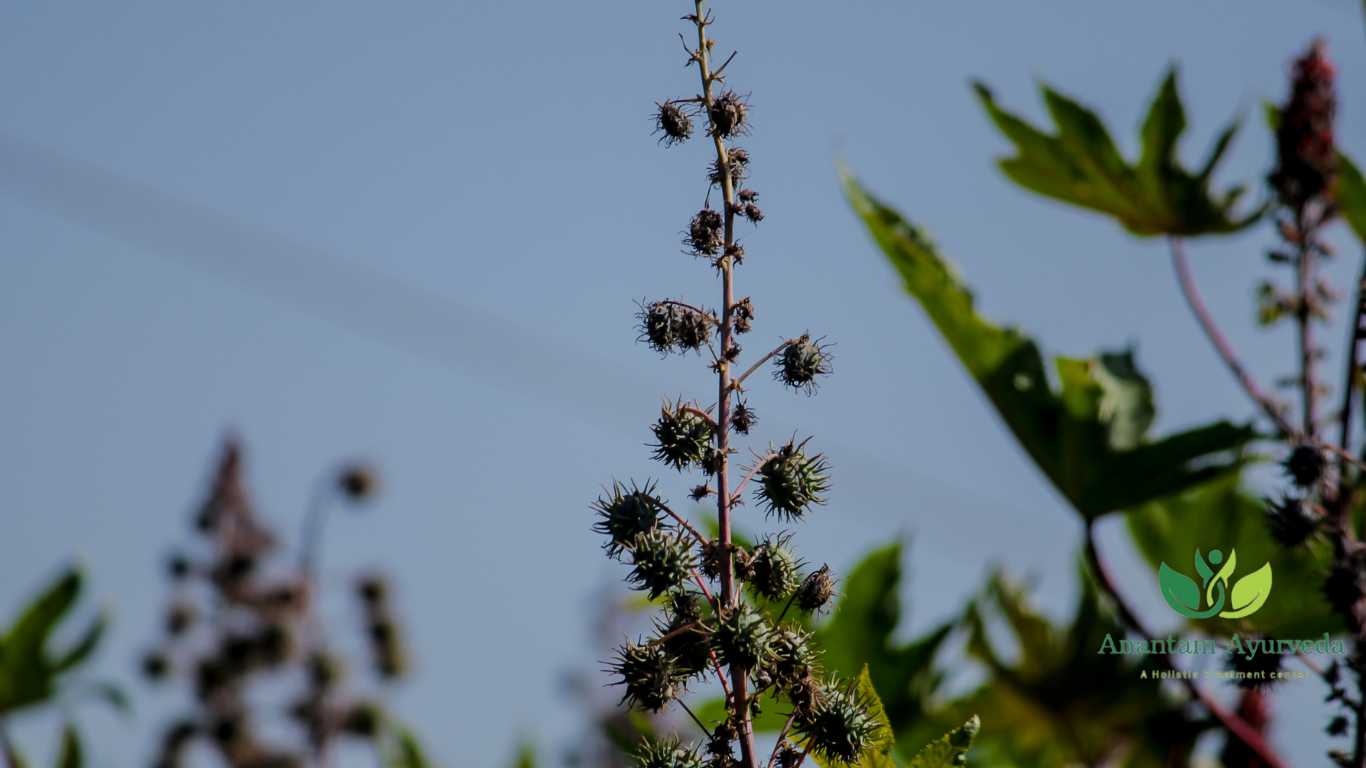
2. Eranda Leaves and Roots:
Apart from the seeds, Eranda leaves and roots are also used in Ayurvedic formulations.
-
- Decoctions: Boil Eranda leaves or roots in water to create a decoction. This can be consumed orally to relieve digestive issues and promote bowel movements.
- Powder Form: You can dry Eranda leaves or roots and make powder of them . Consume this powder with honey or warm water. People often use it to address specific health concerns.
-
Use of Castor Leaves in Panchakarma (Ayurvedic Detox Therapy)
In Panchakarma, castor leaves play a role in Swedana (sweating therapy), particularly in the Prastara Swedana method.
Prastara Swedana –
-
Process:
-
A bed of boiled herbal substances is spread on a flat stone.
-
Fresh castor leaves are layered over the herbs.
-
The patient lies on this warm herbal bed for several minutes.
-
The treatment induces sweating, helps relieve joint pain, stiffness, and Vata-related disorders.
-
-
3. External Poultice:
Eranda leaves can be crushed and used as a poultice. Applying this poultice on swollen joints or inflamed areas helps in reducing pain and inflammation.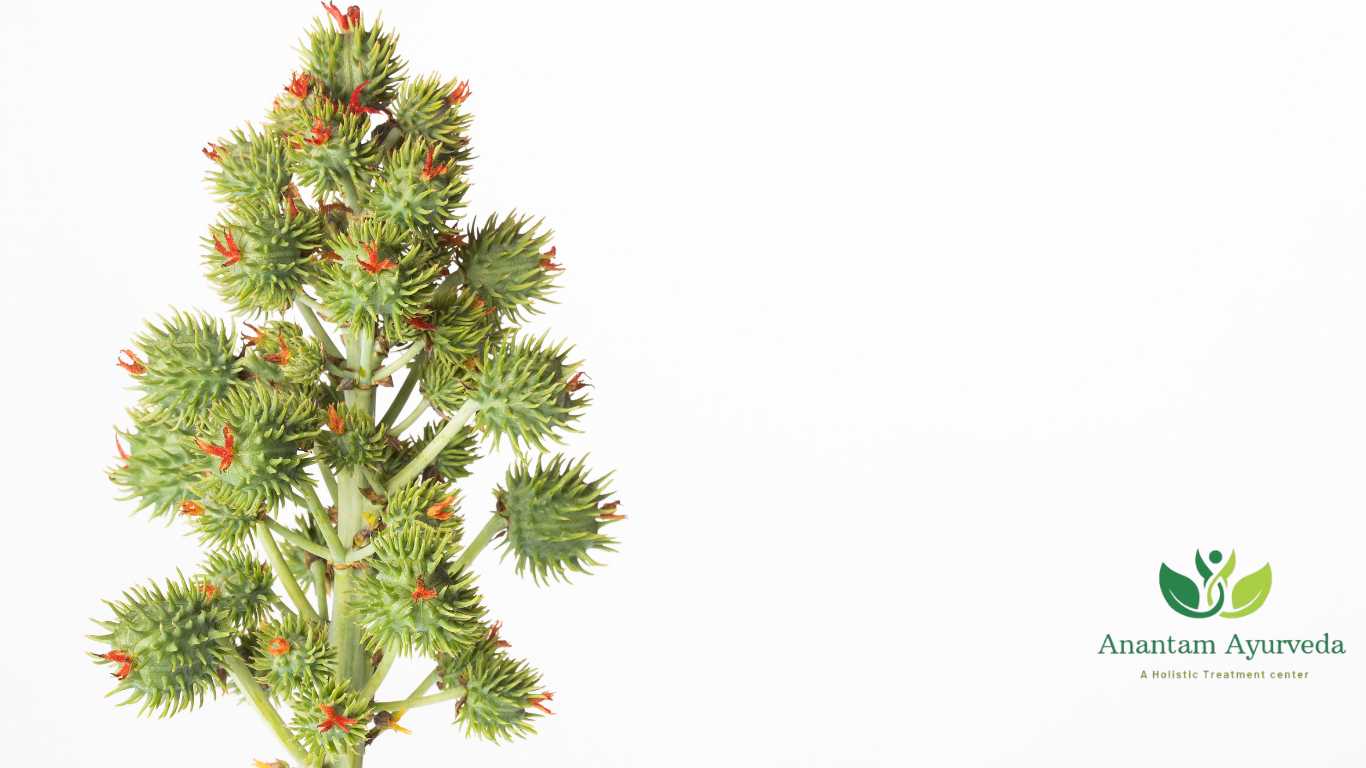
4. Eranda in Ayurvedic Formulations:
It is a key ingredient in various Ayurvedic formulations. It is often combined with other herbs to create specific medicines tailored to different health issues.
Classical Ayurvedic Formulations with Eranda (Castor Oil)
Eranda (castor oil) plays a crucial role in Ayurveda, offering powerful therapeutic benefits. Various classical Ayurvedic formulations utilize Eranda to treat constipation, joint inflammation, skin disorders, and other ailments.
1. Murchita Eranda Taila
This specially processed castor oil helps relieve constipation, supports weight management, and reduces mild inflammation. Herbs like Manjishta, Musta, Dhanyaka, and Triphala enhance its medicinal properties. Pregnant and breastfeeding women should avoid this formulation.
2. Nonganadi Eranda Tailam
This herbal oil effectively treats filariasis and testicular swelling. It combines castor oil with powerful herbs like Patha (Cyclea peltata) and Karkataka Sringi (Pistacia integerrima). People experiencing diarrhea, dysentery, or pregnancy should avoid using it.
3. Gandharvahastadi Eranda Tailam
This medicated oil alleviates constipation, inflammatory joint disorders, and musculoskeletal diseases. It blends Eranda (Ricinus communis) with Yava (Hordeum vulgare) and Shunti (Zingiber officinale). Typically, the recommended dosage is 5-7 drops in lukewarm water, but consulting an Ayurvedic practitioner ensures proper usage.
4. Nimbamritadi Eranda Tailam
This herbal oil treats skin disorders and rheumatoid arthritis. Its formulation includes castor oil infused with Nimba (Azadirachta indica) and Amrita (Tinospora cordifolia). People with diarrhea, dysentery, pregnancy, or young children should avoid it.
5. Eranda Taila (Castor Oil)
Description: Pure castor oil extracted from Ricinus communis seeds.
Therapeutic Uses:
-
Vata Disorders: Effectively alleviates arthritis, sciatica, and paralysis.
-
Digestive Issues: Acts as a natural purgative, relieving constipation.
-
Skin Conditions: Applied externally to soothe inflammation and heal wounds.
6. Gandharvahastadi Kashayam
Description: A decoction made primarily from Eranda roots, blended with other medicinal herbs.
Therapeutic Uses:
-
Digestive Health: Relieves bloating, abdominal pain, and constipation.
-
Detoxification: Helps eliminate accumulated toxins (Ama) from the body.
7. Eranda Pak
Description: A medicinal confection prepared with castor root, milk, and jaggery.
Therapeutic Uses:
-
Joint Health: Beneficial for managing rheumatoid arthritis and gout.
-
Nervous System Support: Aids in treating neurological disorders linked to Vata imbalance.
8. Nirgundi-Eranda Taila
Description: A medicated oil combining Nirgundi (Vitex negundo) and Eranda.
Therapeutic Uses:
-
Pain Relief: Effectively reduces joint and muscular pain.
-
Inflammation Reduction: Alleviates swelling and stiffness in arthritic conditions.
9. Erandamuladi Niruha Basti
Description: An enema formulation where Eranda root decoction plays a key role.
Therapeutic Uses:
-
Vata Disorders: Helps treat lower back pain, sciatica, and neuromuscular conditions.
-
Colon Detoxification: Cleanses the digestive tract and balances Vata dosha.
10. Dashamoola Kwatha
Description: A decoction featuring ten roots, including Eranda, known as Dashamoola.
Therapeutic Uses:
-
Respiratory Health: Helps treat bronchitis and asthma.
-
Anti-inflammatory Benefits: Reduces inflammation in musculoskeletal disorders.
11. Chaturbhadra Taila
Description: A medicated oil infused with Eranda and three other primary herbs.
Therapeutic Uses:
-
Skin Disorders: Helps manage eczema, psoriasis, and other skin diseases.
-
Pain Management: Provides relief from headaches and body aches.
12. Eranda Bhrishta Haritaki
Description: A formulation where Haritaki (Terminalia chebula) is fried in castor oil.
Therapeutic Uses:
-
Digestive Aid: Enhances digestion and relieves constipation.
-
Respiratory Health: Beneficial in treating cough and cold.
5. Dosage:
The appropriate dosage of Eranda and its formulations varies based on the specific health condition, the individual’s constitution, and the practitioner’s advice. It’s crucial to consult an experienced Ayurvedic practitioner to determine the correct dosage for your needs.
Key Safety Guidelines
-
Avoid self-medicating with castor seeds or raw seed powder.
-
Always consult an Ayurvedic physician or healthcare provider before internal use.
-
Use only purified and processed parts under expert supervision.
-
External application of leaves or oil is generally safe and widely practiced in traditional therapies.
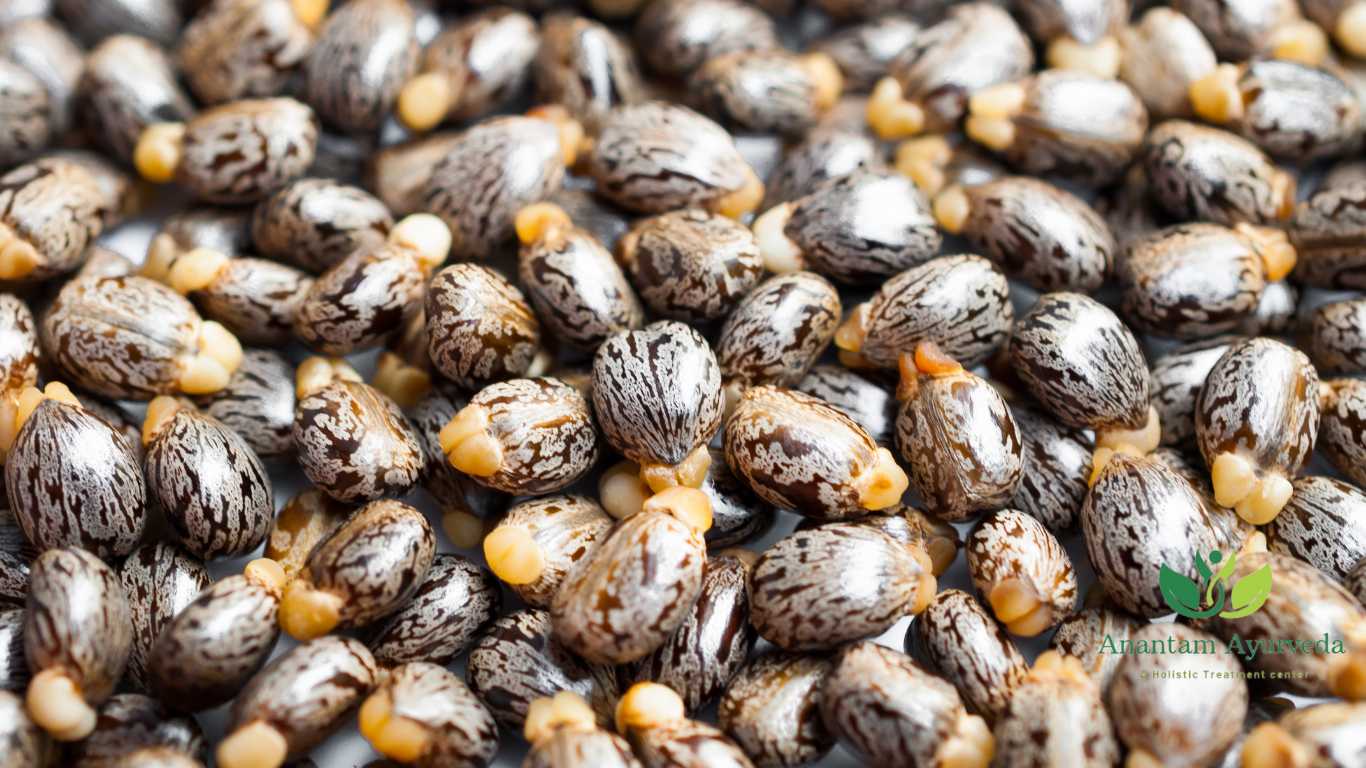
In conclusion, Eranda, or Ricinus communis, emerges as a holistic healer deeply intertwined with the wisdom of Ayurveda. Its remarkable qualities, ranging from digestive support to pain relief, make it a valuable asset in natural medicine. By embracing the therapeutic potential of Eranda, one can embark on a transformative journey towards enhanced well-being.
Frequently Asked Questions (FAQs) About Eranda (Castor Oil)
Eranda, commonly known as castor oil, comes from the seeds of Ricinus communis and plays a vital role in Ayurveda. It supports digestive health, relieves joint pain, enhances skin care, and promotes hair growth. Below are common questions and answers about Eranda to help you understand its benefits and uses.
1. What Are the Primary Benefits of Eranda?
Eranda offers a wide range of therapeutic benefits, including:
-
Laxative Properties: Effectively relieves constipation and supports digestion.
-
Anti-Inflammatory Action: Reduces joint pain and arthritis-related discomfort.
-
Skin Care: Moisturizes dry skin, promotes wound healing, and fights infections.
-
Hair Health: Strengthens hair, nourishes the scalp, and reduces dandruff.
2. How Does Eranda Improve Digestive Health?
Eranda acts as a natural purgative, promoting regular bowel movements and relieving constipation. It detoxifies the digestive system, supporting gut health and improving metabolism.
3. Can Eranda Help With Pain Relief?
Yes, Eranda contains ricinoleic acid, which has strong anti-inflammatory properties. It helps reduce pain, swelling, and stiffness in conditions like arthritis, muscle soreness, and joint discomfort.
4. How Does Eranda Benefit the Skin?
Eranda hydrates and protects the skin. It treats dryness, soothes inflammation, and accelerates wound healing. Its antimicrobial properties help manage skin infections and conditions like eczema and psoriasis.
5. How Does Eranda Support Hair Growth?
Regular application of Eranda oil nourishes hair follicles, strengthens roots, and promotes thicker hair growth. It also prevents dryness, reduces scalp irritation, and controls dandruff.
6. Are There Any Precautions When Using Eranda?
Using Eranda safely is essential to avoid side effects. Consider the following:
-
Proper Dosage: Overuse may lead to diarrhea and dehydration.
-
Pregnancy & Breastfeeding: Consult a doctor before using it, as it may induce labor or affect lactation.
-
Allergies: Perform a patch test before topical application to check for sensitivity.
7. How Is Eranda Used in Ayurveda?
Ayurveda incorporates Eranda in oils, decoctions, and medicinal preparations to balance Vata and Kapha doshas. It plays a key role in treating arthritis, digestive disorders, and skin ailments.
8. Does Eranda Help With Detoxification?
Yes, Eranda is widely used in Ayurvedic detox therapies to cleanse the colon and eliminate toxins. It helps restore digestive balance and promotes overall well-being.
9. Is Eranda Safe for Everyone?
While Eranda benefits most people, individuals with certain conditions should seek medical advice before use. Those with digestive disorders, pregnant women, and people allergic to castor oil should take precautions.
10. How Should Eranda Oil Be Stored?
To preserve its quality, store Eranda oil in a cool, dry place away from direct sunlight. Proper storage maintains its potency and extends shelf life.
Eranda offers natural healing properties that support digestion, relieve pain, improve skin health, and strengthen hair. Using it correctly ensures maximum benefits while minimizing risks. Always consult an Ayurvedic expert before adding Eranda to your wellness routine.
You can follow us on twitter, facebook, instagram & Google News

2 Comments